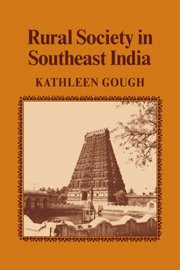Book contents
- Frontmatter
- Contents
- Preface
- Part I Thanjāvūr
- Part II Kumbapeṭṭai
- 8 The Face of the Village
- 9 Kumbapeṭṭai before 1855
- 10 Kumbapeṭṭai from 1855 to 1952
- 11 The Annual Round
- 12 Economics and Class Structure: The Petty Bourgeoisie
- 13 Independent Commodity Producers and Traders
- 14 The Semiproletariat
- 15 Village Politics: Religion, Caste, and Class
- 16 Village Politics: The Street Assembly
- 17 Class Struggle and Village Power Structure
- Part III Kirippūr
- Notes
- Glossary
- Bibliography
- Index
- CAMBRIDGE STUDIES IN SOCIAL ANTHROPOLOGY
17 - Class Struggle and Village Power Structure
from Part II - Kumbapeṭṭai
Published online by Cambridge University Press: 29 October 2009
- Frontmatter
- Contents
- Preface
- Part I Thanjāvūr
- Part II Kumbapeṭṭai
- 8 The Face of the Village
- 9 Kumbapeṭṭai before 1855
- 10 Kumbapeṭṭai from 1855 to 1952
- 11 The Annual Round
- 12 Economics and Class Structure: The Petty Bourgeoisie
- 13 Independent Commodity Producers and Traders
- 14 The Semiproletariat
- 15 Village Politics: Religion, Caste, and Class
- 16 Village Politics: The Street Assembly
- 17 Class Struggle and Village Power Structure
- Part III Kirippūr
- Notes
- Glossary
- Bibliography
- Index
- CAMBRIDGE STUDIES IN SOCIAL ANTHROPOLOGY
Summary
The Settlement of Civil Disputes
When men of the lower classes could not reach agreement through their own assemblies, it was common for them to take their grievances to the landlords. In 1952 the Pallars did this more frequently than the Non-Brahmans for reasons given earlier, but some Non-Brahmans still approached the landlords with their disputes. Disputants might go to their own landlords, who would jointly effect a compromise, or to the panchāyat president or the village headman.
Several of these voluntary referrals of disputes occurred during my visit, and earlier cases were reported. Soon after I arrived, the panchāyat president settled a dispute over vegetable marrows among some of his Paḷḷar servants. Two Paḷḷar brothers, Karuppan and Vēlan, had brought their divorced sister Tulassi back to live near them in Kumbapeṭṭai and, with the landlord's consent, had settled her on a house site next to their own. Tulassi grew some marrows on a patch of garden behind her house. Some of the plants strayed into the next door patch of her second brother, Vēlan, whose wife plucked ten marrows without her knowledge. Tulassi quarreled with her, and told Karuppan that although she was willing to give marrows to him, she would not give them to Vēlan or his wife. The brothers then quarreled and fought. Karuppan's wife summoned her landlord, the panchāyat president, being afraid that the brothers might kill each other.
- Type
- Chapter
- Information
- Rural Society in Southeast India , pp. 318 - 338Publisher: Cambridge University PressPrint publication year: 1982



